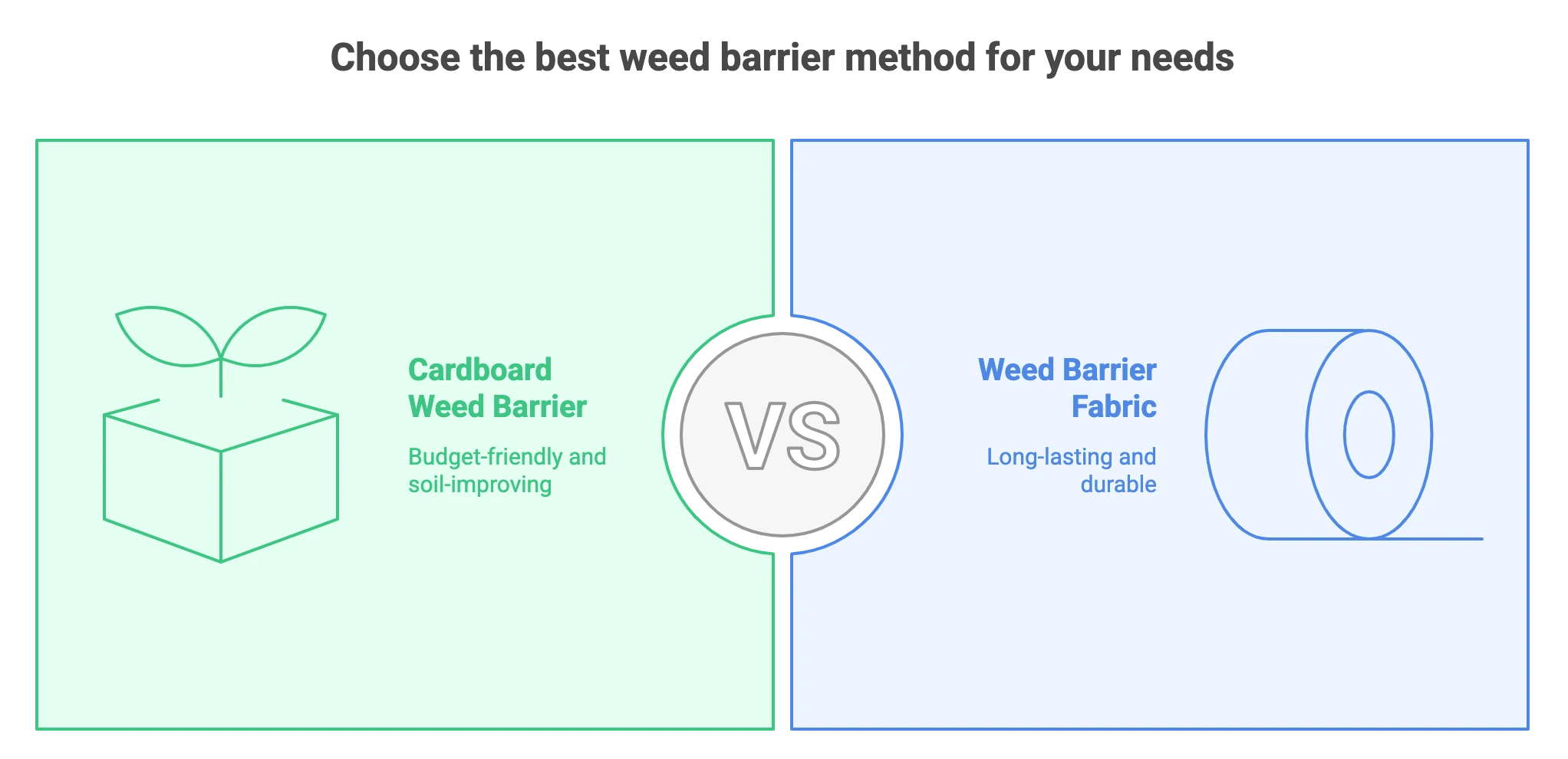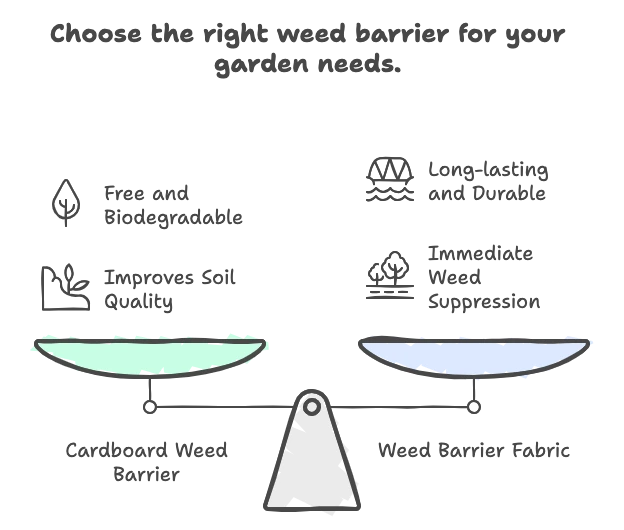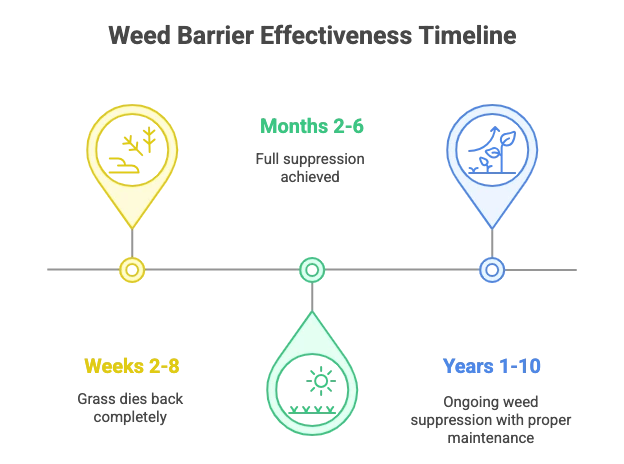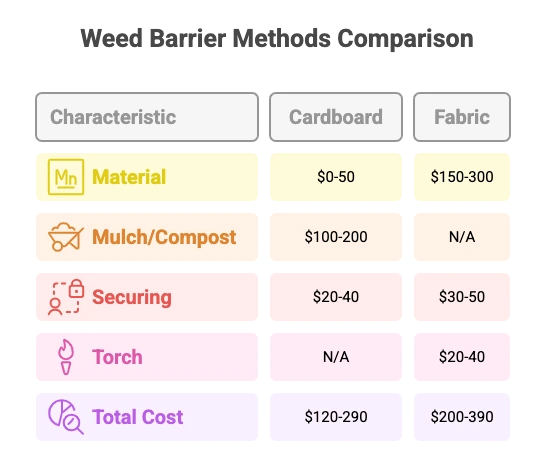Tired of spending your weekends digging up grass? There’s a smarter way. The smothering method lets you kill unwanted grass without chemicals or backbreaking labor—you just cover it up and let nature do the work.
This isn’t the “lazy” way to remove grass; it’s the smart way. Whether you choose a cardboard weed barrier or professional weed barrier fabric, understanding how smothering works and following proven techniques will help you successfully eliminate unwanted turf while building better soil for whatever comes next. Let’s dive into everything you need to know to make this method work for you.
What Is the Smothering Method and Why Does It Work?
The smothering method involves covering grass with materials that block sunlight and air, essentially suffocating the plants beneath. Without light for photosynthesis and with limited air circulation, grass gradually weakens and dies over weeks to months.
This approach works because grass—like all plants—needs sunlight to survive. By creating an effective barrier, you’re essentially creating a controlled environment where the existing vegetation exhausts its stored energy reserves trying to grow through the covering, eventually giving up entirely.
The beauty of smothering lies in its simplicity: no digging, no chemicals, and minimal ongoing effort once you’ve got everything in place. Plus, depending on your chosen weed barrier material, you’re often improving soil quality at the same time.
Note: If you prefer immediate results and don’t mind some physical work, manual grass removal with basic tools is always an option for smaller areas.
Cardboard Weed Barrier vs. Weed Barrier Fabric: Choosing Your Method
Both cardboard weed barrier and professional-grade landscape fabric can effectively smother grass, but they work differently and excel in different scenarios. Understanding which is the best weed barrier for your specific situation is crucial for success.

Cardboard Weed Barrier: The Soil Builder
Best for: Creating new garden beds, improving soil quality, budget-conscious projects
Is cardboard a good weed barrier? Absolutely, when used correctly. Understanding the pros and cons of using cardboard in landscaping can help you make the best decision for your situation. Here’s why:
Pros:
- Often available for free (check Facebook Marketplace or ask local businesses)
- Adds organic matter as it decomposes, improving soil structure
- Completely biodegradable and environmentally friendly
- Easy to cut holes for planting
- No long-term commitment—breaks down naturally
Cons:
- Takes 1-2 years to fully decompose
- Initially water-repellent until thoroughly saturated
- Can attract termites (cardboard weed barrier termites are a real concern near wooden structures)
- Requires thick mulch layer on top for best results
- May need replacement if breakdown occurs too quickly

Best Weed Barrier Fabric: The Long-Term Solution
Best for: Areas under permanent features like hedges, long-term weed suppression, high-maintenance weed areas
Professional heavy duty weed barrier fabric offers different advantages:
Pros:
- Allows air and water through while blocking weeds
- Can last 5-10 years with proper installation
- Immediate barrier that doesn’t need time to decompose
- Excellent for suppressing aggressive weeds like bindweed
- Can be planted through with burned holes
Cons:
- Higher upfront cost than cardboard
- Must be professional-grade woven fabric (avoid cheap big-box store versions)
- Requires special tools (torch, heavy-duty staples)
- Weeds can grow on top if debris accumulates
- Not biodegradable—permanent installation
⚠️ Critical Warning: Only use professional-grade woven landscape fabric, not the felt-backed or solid versions from big box stores. These cheaper alternatives often fail within a season and may actually make weed problems worse. Learn from common weed fabric mistakes that can save you time and money.
How to Install Weed Barrier: Complete Step-by-Step Process
Learning how to install weed barrier properly is essential for success. The process varies slightly depending on whether you’re using cardboard or fabric.
Phase 1: Preparation (1-2 Days)
For All Weed Barrier Methods:
- Mow the grass as short as possible – this reduces the bulk under your covering material
- Edge cleanly along hardscaping – use a shovel to create clean lines where grass meets driveways, walkways, or patios
- Remove any large debris – sticks, rocks, or thick weeds that might poke through your covering
- Plan your coverage pattern – measure the area and calculate material needs
Can you put weed barrier over grass? Yes, but preparation is key for both methods.
For Cardboard Weed Barrier:
- Collect enough cardboard to overlap pieces by 4-6 inches
- Remove all tape, staples, and avoid glossy or heavily printed cardboard
- Have your top layer materials ready (compost, mulch, or wood chips)
For Landscape Fabric:
- Purchase professional-grade woven weed barrier fabric (3.2 oz weight recommended)
- Get 6-inch minimum landscape staples (rusty ones grip better)
- Ensure you have a butane torch for cutting and hole-making

Phase 2: How to Lay Weed Barrier
How to Use Cardboard as Weed Barrier:
- Lay cardboard directly over grass – work systematically across your area
- Overlap edges by 4-6 inches – gaps are where grass will sneak through
- Wet each piece thoroughly – use a hose to saturate the cardboard and help it conform to ground contours
- Weigh down immediately – use bricks, stakes, or apply your mulch layer right away
- Apply 2-5 inches of mulch, compost, or wood chips – this prevents cardboard from drying out and blowing away
How to Install Weed Barrier Fabric:
- Wait for settled soil – if ground was recently tilled, wait a few days after rain for soil to compact
- Roll out fabric systematically – work in manageable sections
- Secure with 6-inch staples every 2-3 feet – pay extra attention to edges and seams
- Use torch to cut fabric – never use scissors or knives, which cause fraying that shortens fabric life
- Burn holes for existing plants – use torch to create clean, sealed openings (see professional installation techniques for working around existing plants)
- Leave fabric visible – resist the urge to cover with decorative materials that create weed-growing surfaces
Phase 3: Securing Your Weed Barrier
How to Secure Weed Barrier – Final Steps for Both Methods:
- Walk the entire area checking for gaps, loose edges, or inadequate coverage
- Add extra weight or staples in windy areas
- Mark the area if needed to prevent foot traffic during establishment
- Document your installation date for timeline tracking
Timeline Expectations: How Long Does Weed Barrier Last?
Understanding the timeline helps set realistic expectations and prevents premature disappointment.
How Long Does Cardboard Weed Barrier Last?
- Weeks 1-4: Grass begins yellowing but may still be visible through gaps
- Months 2-3: Most grass dead, some stubborn weeds may persist
- Months 4-6: Complete grass death, cardboard beginning to soften
- Year 1-2: Cardboard fully decomposed, area ready for permanent installation

How Long Does Weed Barrier Last? (Fabric Version)
- Weeks 2-8: Grass dies back completely
- Months 2-6: Full suppression achieved
- Years 1-10: Ongoing weed suppression with proper maintenance
⏰ Pro Tip: Start your weed barrier for garden projects in late fall or early spring for best results. Avoid peak growing season when grass is most vigorous.

Essential Dos and Don’ts: Learn from Others’ Mistakes
Critical DOs:
✅ DO overlap materials generously – 4-6 inches minimum for cardboard, proper seam coverage for fabric
✅ DO secure thoroughly – use enough weight, stakes, or staples to prevent wind damage
✅ DO wet cardboard completely – dry cardboard repels water and won’t conform to ground
✅ DO use professional-grade fabric – the best weed barrier fabric is always professional-grade woven material
✅ DO clean debris off landscape fabric regularly – accumulated soil creates weed-growing medium on top
Critical DON’Ts:
❌ DON’T use cardboard near wooden structures – cardboard weed barrier termites risk is real
❌ DON’T cut landscape fabric with scissors – fraying dramatically shortens lifespan
❌ DON’T install fabric on loose, freshly tilled soil – staples won’t grip properly
❌ DON’T expect overnight results – smothering takes time to work effectively
❌ DON’T skip the mulch layer with cardboard – exposed cardboard dries out and becomes ineffective
What to Do After the Grass Is Dead
Once your weed barrier method has successfully killed the grass, you’re ready for the transformation phase.
For Cardboard Weed Barrier Areas:
- Test soil quality with a simple spade—it should be soft and improved from decomposition
- Remove any remaining cardboard pieces if desired (or leave to continue decomposing)
- Plant directly into the improved soil
- Add additional compost if needed for heavy feeders
For Landscape Fabric Areas:
- Burn clean holes for new plantings using your torch
- Plant through holes into the soil beneath
- Maintain fabric by keeping surface clean of debris
- Consider fabric life expectancy when planning permanent features
Transition Options for Your Weed Barrier for Garden:
- Native plant gardens work beautifully over either method
- Ground cover plants establish well through both approaches
- Hardscaping can be installed over either method
- Food gardens thrive in the improved soil created by biodegradable weed barrier materials like cardboard
For more ideas on what to plant after grass removal, check out these low-maintenance grass alternatives and tips for growing food instead of lawns.
Troubleshooting Common Weed Barrier Problems
Problem: Grass growing through gaps between materials Solution: Add additional overlap, secure loose edges, patch gaps immediately
Problem: Wind lifting cardboard or fabric Solution: Add more weight/staples, check for proper soil preparation, ensure adequate securing
Problem: Weeds growing on top of landscape fabric Solution: Clean accumulated debris regularly, consider leaving fabric visible rather than covering
Problem: Cardboard not conforming to ground contours Solution: Score cardboard in curves, wet more thoroughly, use smaller pieces in complex areas
Problem: Slower results than expected Solution: Check for light gaps, add extra covering, be patient—smothering takes time

Cost Breakdown and Materials Shopping List
Cardboard Weed Barrier Method (500 sq ft area):
- Cardboard: $0-50 (free from businesses or Facebook Marketplace)
- Mulch/Compost: $100-200 (2-3 cubic yards)
- Bricks/Stakes: $20-40 for securing
- Total: $120-290
Best Weed Barrier Fabric Method (500 sq ft area):
- Professional woven weed barrier fabric: $150-300
- 6-inch landscape staples: $30-50 (2-3 boxes)
- Butane torch: $20-40
- Total: $200-390
Essential Tools for Both Weed Barrier Methods:
- Garden hose for watering
- Measuring tape
- Utility knife/razor blades
- Work gloves
- Wheelbarrow for materials transport
Popular Brands to Consider:
- DeWitt weed barrier (professional-grade option)
- Commercial grade weed barrier from landscape supply stores
💰 Money-Saving Tips:
- Check Facebook Marketplace for free cardboard
- Buy heavy duty weed barrier fabric in bulk or during off-season sales
- Borrow or rent specialty tools like torches
- Start with a small test area before committing to large purchases
Frequently Asked Questions
Can I put weed barrier directly over grass?
Yes, both cardboard and landscape fabric can be installed directly over grass after mowing it as short as possible and removing debris. This is actually the preferred method for the smothering technique.
How long does it take for grass to die under a weed barrier?
With cardboard, expect full grass death in 4-6 months; with professional landscape fabric, most grass dies within 2-8 weeks. Patience is key for both methods.
Is it safe to use cardboard near my house?
Avoid using cardboard weed barrier near wooden structures, as it can attract termites. Keep cardboard installations at least 10 feet away from your home’s foundation.
What type of landscape fabric should I use?
Only use professional-grade woven landscape fabric, not felt-backed or cheap big-box store versions. Look for 3.2 oz weight fabric from reputable suppliers like DeWitt or commercial landscaping companies.
What if weeds grow on top of my landscape fabric?
Regularly remove debris and soil that accumulates on top, as it can provide a medium for weeds to grow. This is why leaving fabric visible (not covered with mulch) is recommended.
Can I use newspaper instead of cardboard?
Newspaper can work but requires much thicker layers (10-20 sheets) and breaks down faster than cardboard. It’s better suited for temporary applications or small areas.
Will cardboard attract pests or rodents?
Cardboard can attract termites and potentially other pests. Monitor areas near structures and avoid use near your home’s foundation. The mulch layer on top helps minimize pest attraction.
Which method is better for vegetable gardens?
Cardboard improves soil as it decomposes, making it ideal for vegetable and food gardens. The organic matter it adds creates better growing conditions for edible plants.
How often do I need to replace my weed barrier?
Cardboard typically lasts 1-2 years before fully decomposing; professional landscape fabric can last 5-10 years with proper installation and maintenance.
Where can I get free cardboard for my garden?
Check Facebook Marketplace, local businesses, grocery stores, or appliance stores for free, clean cardboard boxes. Many businesses pay to have cardboard recycled and are happy to give it away.
Your Path to Success with Weed Barrier
The smothering method isn’t magic—it’s science applied with patience. By choosing the right weed barrier material for your situation, following proper installation techniques, and understanding the timeline, you’re setting yourself up for success.
Remember, this is the smart approach to grass removal. Whether you choose cardboard weed barrier for soil building or landscape fabric for long-term suppression, you’re trading a few months of waiting for years of reduced maintenance, improved soil, and the satisfaction of working with nature rather than against it.
Does weed barrier fabric work? When installed properly with professional-grade materials, absolutely. Can you use cardboard as a weed barrier? Yes, and it’s one of the most effective biodegradable weed barrier options available.
Start with a small test area if you’re uncertain, but don’t let perfectionism prevent you from beginning. The best time to start smothering that unwanted grass was six months ago—the second best time is today.
Your future self, relaxing in a beautiful low-maintenance landscape while your neighbors fire up their mowers, will thank you for choosing the patient, intelligent path to yard transformation.

